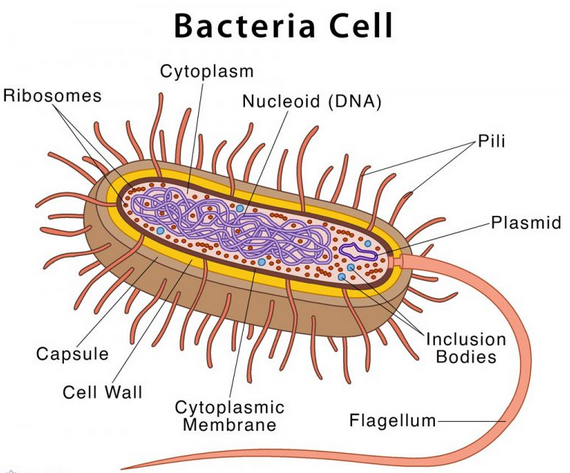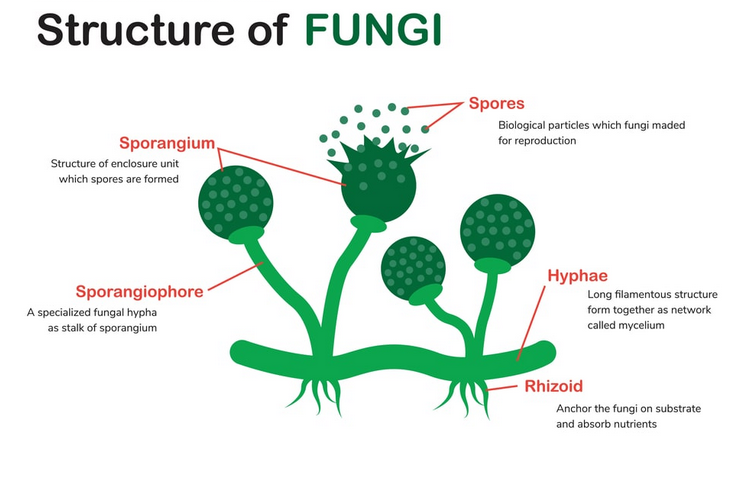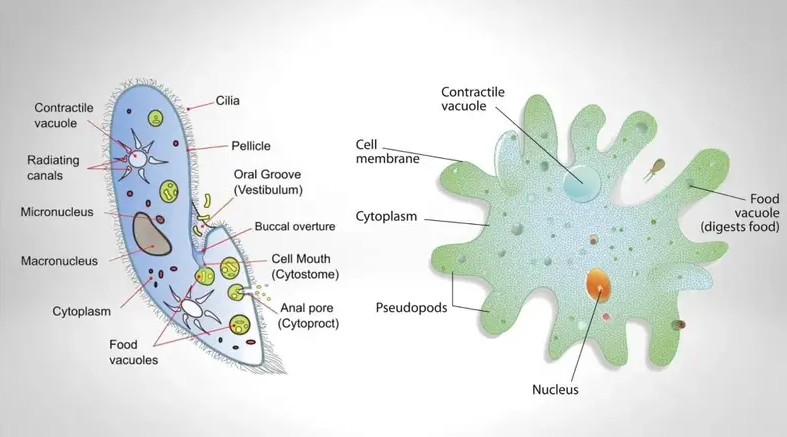Microorganisms, also known as microbes, are organisms that are too small to be seen with the naked eye. They include a wide variety of organisms such as bacteria, archaea, fungi, algae, protozoa, and viruses.
Microorganisms are incredibly diverse and can be found in almost every habitat on Earth, from the depths of the ocean to the highest mountain peaks. They play crucial roles in various ecosystems and have a significant impact on the environment, human health, and the economy.
Bacteria:
Bacteria are single-celled microorganisms that are found almost everywhere on Earth. They have a wide range of shapes and sizes and can be beneficial or harmful to humans. Some bacteria are essential for various processes like digestion, while others can cause diseases.
 |
| Bacteria cell |
Bacteria are single-celled microorganisms that belong to the domain Bacteria. They are one of the most abundant and diverse groups of organisms on Earth. Bacteria are characterized by their prokaryotic cellular structure, which means they lack a nucleus and other membrane-bound organelles.
Here are some key features of bacteria:
1. Cell Structure: Bacteria have a simple cellular structure. They consist of a cell membrane, cytoplasm, and a circular strand of DNA called a nucleoid. Some bacteria also have additional structures like a cell wall, flagella for movement, and pili for attachment.
2. Shapes and Sizes: Bacteria exhibit various shapes including spheres (cocci), rods (bacilli), and spirals (spirilla). They can range in size from a few micrometers to sub-micrometer dimensions.
3. Metabolism: Bacteria have diverse metabolic capabilities. They can be classified as autotrophs or heterotrophs based on their energy source. Autotrophic bacteria can produce their own food using sunlight (photosynthesis) or inorganic compounds (chemosynthesis), while heterotrophic bacteria obtain energy by consuming organic matter.
4. Reproduction: Bacteria reproduce asexually through a process called binary fission. In this process, a single bacterium divides into two identical daughter cells. Some bacteria can also exchange genetic material through horizontal gene transfer, allowing for genetic diversity.
5. Environmental Adaptability: Bacteria are incredibly adaptable and can be found in almost every habitat on Earth, from extreme environments like hot springs and deep-sea hydrothermal vents to soil, water, and the human body. They play essential roles in nutrient cycling, decomposition, and symbiotic relationships with other organisms.
6. Role in Health and Disease: While many bacteria are harmless or even beneficial to humans, some bacteria can cause diseases. Pathogenic bacteria can invade the human body and disrupt normal cellular functions, leading to infections. However, bacteria also have important roles in maintaining human health, such as aiding digestion and supporting the immune system.
Bacteria have a profound impact on the environment, human health, and various industries. They are used in food production (e.g., yogurt, cheese), biotechnology, waste treatment, and the production of antibiotics. Research on bacteria continues to expand our understanding of their diversity, ecological roles, and potential applications.
2. Viruses:
Viruses are tiny infectious agents that can only replicate inside the cells of other organisms. They consist of genetic material (DNA or RNA) enclosed in a protein coat. Viruses cause various diseases in humans, animals, and plants, such as the common cold, flu, HIV/AIDS, and COVID-19. Viruses are tiny infectious agents that can only replicate inside the cells of other organisms. They consist of genetic material, either DNA or RNA, enclosed in a protein coat called a capsid. Some viruses also have an outer envelope derived from the host cell's membrane. Viruses are considered non-living entities because they lack the ability to carry out metabolic functions on their own and require a host cell to reproduce.
 |
| Structure of viruses |
Viruses have a remarkable ability to infect a wide range of organisms, including humans, animals, plants, and even bacteria. They are responsible for causing numerous diseases, ranging from the common cold and flu to more severe conditions like measles, HIV/AIDS, Ebola, and COVID-19. Each virus has specific characteristics that determine its host range, the cells it can infect, and the symptoms it produces.
The lifecycle of a virus typically involves several stages: attachment, entry, replication, assembly, and release. To infect a host cell, a virus must first attach to specific receptors on the cell surface. It then enters the cell, either by fusing with the cell membrane or being engulfed by the cell. Once inside, the viral genetic material takes control of the cellular machinery, redirecting it to produce new virus particles. These particles are then assembled and released to infect other cells and propagate the infection.
Viruses can be transmitted through various routes, depending on the specific virus. Respiratory droplets, direct contact with infected individuals, contaminated surfaces, sexual contact, and insect vectors are common modes of transmission. Preventing viral infections often involves practicing good hygiene, such as regular handwashing, wearing masks, maintaining social distancing, and vaccination when available.
The study of viruses, known as virology, is a crucial field of research. Scientists continuously strive to understand the structure, function, and behavior of viruses to develop effective diagnostic tools, antiviral therapies, and vaccines. Ongoing surveillance and monitoring of viral outbreaks are essential for public health preparedness and response.
While viruses are predominantly associated with causing diseases, it's important to note that not all viruses are harmful to humans. Some viruses have beneficial roles in ecosystems, such as controlling populations of other organisms or transferring genetic material between species. Additionally, viruses are utilized as tools in biological research, including gene therapy and the development of vaccines.
In summary, viruses are highly specialized infectious agents that invade host cells to replicate and cause a wide range of diseases. Understanding the biology of viruses is crucial for developing strategies to prevent, diagnose, and treat viral infections and ultimately protect human and animal health.
3. Fungi:
Fungi are eukaryotic microorganisms that include molds, yeasts, and mushrooms. They are characterized by their filamentous structures called hyphae. Fungi play important roles in decomposition and nutrient recycling. Some fungi can cause infections in humans, while others have beneficial uses like producing antibiotics or food (e.g., yeast). Fungi are a diverse group of eukaryotic microorganisms that belong to the kingdom Fungi. They encompass a wide range of organisms, including molds, yeasts, and mushrooms. Fungi are distinct from plants, animals, and bacteria in terms of their cellular structure, mode of nutrition, and reproductive mechanisms.
 |
| Structure of fungi |
One key characteristic of fungi is their filamentous structure called hyphae. These hyphae intertwine to form a network called mycelium, which is typically hidden within the substrate on which the fungus grows. The mycelium serves as the main body of the fungus and plays a crucial role in nutrient absorption and distribution.
Fungi have a unique mode of nutrition known as heterotrophic nutrition. Unlike plants that can produce their own food through photosynthesis, fungi cannot synthesize their own nutrients. Instead, they acquire nutrients by decomposing organic matter or by forming mutualistic associations with other organisms. Some fungi are saprophytic, meaning they obtain nutrients by breaking down dead organic material. Others are parasitic or symbiotic, establishing relationships with plants, animals, or other fungi to obtain nutrients.
Reproduction in fungi occurs through the production of spores. These spores are often microscopic and can be dispersed by air, water, or other means. When conditions are favorable, the spores germinate and give rise to new fungal colonies. Fungi can reproduce both sexually and asexually, depending on the species and environmental conditions.
Fungi play crucial roles in ecosystems and have a significant impact on the environment. They are involved in the decomposition of organic matter, breaking down complex compounds into simpler forms and facilitating nutrient recycling. Fungi also form symbiotic relationships with plant roots, known as mycorrhizae, which enhance nutrient uptake and support plant growth.
In addition to their ecological importance, fungi have numerous practical applications. They are widely used in the food industry for fermentation processes, such as the production of bread, beer, wine, and cheese. Fungi also have medical significance, with some species producing antibiotics that are used to treat bacterial infections.
However, fungi can also cause diseases in humans and other organisms. Fungal infections, or mycoses, can affect various parts of the body, including the skin, nails, respiratory system, and internal organs. Examples of fungal infections in humans include athlete's foot, ringworm, and candidiasis.
In summary, fungi are eukaryotic microorganisms that encompass a diverse group of organisms, including molds, yeasts, and mushrooms. They play essential roles in decomposition, nutrient cycling, and symbiotic relationships in ecosystems. Fungi have practical applications in food production, medicine, and other industries. Understanding fungi is crucial for both their ecological significance and their impact on human health.
4. Protozoa:
Protozoa are single-celled eukaryotic organisms that typically live in water or soil. They come in various shapes and move using structures like cilia, flagella, or pseudopods. Some protozoa are free-living, while others are parasites that can cause diseases such as malaria and amoebic dysentery. Protozoa are a group of single-celled, eukaryotic microorganisms that belong to the Kingdom Protista. They are characterized by their ability to move and feed on other microorganisms or organic matter. Protozoa exhibit a diverse range of shapes, sizes, and modes of locomotion, making them a highly diverse group of organisms.
 |
Protozoa Structure and Locomotor Organelles |
Unlike bacteria, which are prokaryotic, protozoa have a true nucleus and other membrane-bound organelles within their cells. They can be classified into various groups based on their mode of locomotion, including flagellates, ciliates, amoebas, and sporozoans.
Flagellates possess whip-like structures called flagella, which they use for movement. They can be found in aquatic environments such as freshwater, saltwater, and soil. Some flagellates are free-living, while others are parasitic and can cause diseases in humans and animals. Examples of flagellates include Trypanosoma, which causes sleeping sickness, and Giardia lamblia, which causes giardiasis.
Ciliates are characterized by the presence of tiny hair-like structures called cilia that cover their cell surface. These cilia beat in coordinated patterns, allowing ciliates to move and direct food particles into their mouths. Paramecium is a well-known example of a ciliate.
Amoebas move using temporary extensions of their cell called pseudopodia, which allow them to change shape and move in a flowing manner. Amoebas capture food particles by engulfing them into their cytoplasm through pseudopodia. Entamoeba histolytica is an example of an amoeba that can cause amoebic dysentery.
Sporozoans are non-motile protozoa that usually have complex life cycles involving both sexual and asexual reproduction stages. They are often parasitic and can cause diseases such as malaria (Plasmodium species) and toxoplasmosis (Toxoplasma gondii).
Protozoa can be found in a wide range of habitats, including freshwater, marine environments, soil, and the digestive systems of animals. They play important roles in various ecosystems as consumers, decomposers, and as part of the microbial food web. Some protozoa also form symbiotic relationships with other organisms, such as mutualistic associations with termites and rumen-dwelling protozoa in cattle.
While some protozoa are harmless or beneficial, others can cause diseases in humans, animals, and plants. Protozoan infections can be transmitted through contaminated water, food, or vectors such as mosquitoes and ticks. Common examples of protozoan diseases include malaria, amoebic dysentery, Chagas disease, and toxoplasmosis.
In conclusion, protozoa are single-celled, eukaryotic microorganisms that exhibit a wide variety of shapes, sizes, and modes of locomotion. They are an important part of microbial ecosystems and can have both beneficial and harmful effects on humans and other organisms. Understanding protozoa is essential for studying their ecological roles, their impact on human health, and developing strategies to prevent and treat protozoan diseases.
5. Archaea:
Archaea are a group of single-celled microorganisms that are genetically distinct from bacteria and eukaryotes. They thrive in extreme environments like hot springs, deep-sea hydrothermal vents, and salt lakes. Archaea play crucial roles in biogeochemical cycles and have contributed to our understanding of life's diversity and evolution. Archaea, also known as archaebacteria, are a group of microorganisms that constitute one of the three domains of life, alongside bacteria and eukaryotes. Archaea are single-celled organisms that share some similarities with both bacteria and eukaryotes but also possess unique characteristics that distinguish them from other organisms.
 |
Archaea cell |
Archaea are prokaryotic microorganisms, meaning they lack a nucleus and membrane-bound organelles. However, they have distinct differences in their cell structure compared to bacteria. One of the notable features of archaea is the absence of peptidoglycan in their cell walls, which is a characteristic feature of bacteria.
Archaea are known for their ability to thrive in extreme environments, such as hot springs, deep-sea hydrothermal vents, and highly acidic or alkaline conditions. They are often referred to as extremophiles due to their remarkable tolerance to extreme temperatures, salinity, and pH levels.
These microorganisms are also involved in various ecological processes. For example, methanogenic archaea are responsible for producing methane gas in anaerobic environments such as swamps and the digestive systems of ruminant animals. Other archaea can obtain energy through chemosynthesis, using inorganic compounds like sulfur or hydrogen as energy sources.
Archaea have important implications in biotechnology, environmental studies, and evolutionary research. Their unique genetic and metabolic characteristics make them intriguing subjects for scientific study and contribute to our understanding of the diversity and adaptability of life on Earth.
6. Algae:
Algae are photosynthetic microorganisms that range from single-celled to multicellular organisms. They can be found in diverse habitats like freshwater, marine environments, and even on moist surfaces. Algae are important producers of oxygen and serve as the base of many food chains. Some types of algae can produce harmful algal blooms or toxins. Algae are diverse groups of photosynthetic organisms that range from microscopic single-celled forms to large multicellular organisms. They are classified as a part of the Kingdom Protista and are found in a variety of aquatic environments, including freshwater, marine, and moist terrestrial habitats.
 |
| Algae |
Algae are eukaryotic organisms, meaning they have a nucleus and other membrane-bound organelles. They contain chloroplasts, which enable them to carry out photosynthesis and convert sunlight into energy. This process allows algae to produce oxygen and organic compounds that are vital for other organisms in the ecosystem.
Algae exhibit a wide range of sizes, shapes, and colors. Some species are unicellular, such as Chlorella and diatoms, while others form colonies or multicellular structures. Green algae, such as Spirogyra and Chlamydomonas, are often found in freshwater habitats and are commonly referred to as pond scum. Red algae, such as Porphyra (nori) and Gracilaria, are widely used in food products. Brown algae, such as kelp, can grow to substantial sizes and form underwater forests.
Algae play crucial roles in the environment and have various ecological functions. They serve as primary producers, contributing to the food chain by providing food and oxygen for other organisms. Additionally, they play a significant role in nutrient cycling and can help mitigate water pollution through their ability to absorb and remove excess nutrients from aquatic environments.
Algae also have commercial and industrial applications. They are used as food sources for humans and animals, particularly in Asian cuisine. Certain algae species are cultivated for their high nutritional value, such as Spirulina and Chlorella. Algae are also used in the production of biofuels, pharmaceuticals, cosmetics, and as a source of pigments for dyes and food coloring.
Overall, algae are a diverse group of organisms with significant ecological, economic, and scientific importance. Their ability to photosynthesize and their wide range of adaptations make them essential components of various ecosystems and valuable resources for human use.
These are just a few examples of the many types of microorganisms that exist. Each type has its own unique characteristics, ecological roles, and impacts on human health and the environment.
Prions:
Prions are unique infectious agents that consist solely of proteins and do not contain any genetic material like DNA or RNA. They are known for their ability to cause rare but devastating neurodegenerative diseases in humans and animals. The term "prion" is derived from "proteinaceous infectious particle."
Prions are mainly associated with diseases known as transmissible spongiform encephalopathies (TSEs), which affect the brain and nervous system. These diseases include Creutzfeldt-Jakob disease (CJD) in humans, variant Creutzfeldt-Jakob disease (vCJD), fatal familial insomnia (FFI), and Gerstmann-Sträussler-Scheinker syndrome (GSS), among others.
 |
| Prions |
The hallmark of prion diseases is the conversion of a normal cellular protein, called the prion protein (PrP), into an abnormal form. The abnormal prion protein, known as PrPSc, has a different conformation and can induce other normal prion proteins to adopt the abnormal shape. This conversion process leads to the accumulation of PrPSc in the brain, causing damage to nerve cells and the characteristic symptoms of the disease.
Prion diseases can be sporadic, genetic, or acquired through exposure to infected tissues. In some cases, prion diseases are inherited due to mutations in the prion protein gene (PRNP). They can also be acquired through the consumption of contaminated meat products, as seen in the case of bovine spongiform encephalopathy (BSE) or "mad cow disease."
Prion diseases are challenging to diagnose and treat. They often have long incubation periods, and symptoms may take years to manifest. Diagnosis is typically confirmed through brain tissue examination after the individual has died. Unfortunately, there are currently no effective treatments or cures for prion diseases, and they are often fatal.
The study of prions and prion diseases has provided valuable insights into protein misfolding and its role in neurodegenerative disorders. Understanding prion biology is crucial for developing diagnostic tools, therapeutic strategies, and preventive measures to combat these rare but devastating diseases.
In summary, prions are unique infectious agents composed solely of abnormal proteins. They cause a group of rare neurodegenerative diseases known as transmissible spongiform encephalopathies. Despite their simplicity, prions have a profound impact on human and animal health, and ongoing research aims to unravel the mysteries of these fascinating and destructive agents.
Lichens :
Lichens are unique organisms that result from a mutualistic association between a fungus and a photosynthetic microbe, either an alga or a cyanobacterium. This symbiotic relationship allows both organisms to benefit and thrive in various environments. Lichens are known for their ability to colonize and survive in extreme habitats, including rocks, trees, and even harsh arctic or desert environments.
 |
| lichen |
The structure of a lichen consists of distinct layers. The top layer is composed of a tightly woven network of fungal hyphae, forming the fungal partner of the lichen. Beneath the fungal layer, the photosynthetic microbe, such as an alga or cyanobacterium, resides in a middle layer. The photosynthetic microbe is responsible for converting sunlight into energy through photosynthesis, producing nutrients that are shared with the fungus. The bottom layer consists of fungal mycelium that anchors the lichen to its substrate.
One of the remarkable characteristics of lichens is their ability to transform bare rock into soil. Lichens produce acids that slowly break down rocks over time, aiding in the weathering and erosion processes. This process is crucial for the formation of new soil, which in turn supports the growth of other plants and organisms.
Lichens have adapted to survive in diverse habitats, ranging from forests and grasslands to rocky cliffs and tundra. They can be found on trees, rocks, soil, and even man-made structures. Some lichens have a crust-like appearance, known as crustose lichens, which adhere tightly to their substrates. Crustose lichens play a vital ecological role in stabilizing soil and preventing erosion.
Lichens have significant ecological importance as pioneers in colonizing barren habitats and contributing to primary succession. They serve as a food source for various animals, including reindeer and certain insects. Lichens also contribute to nitrogen fixation, enhancing nutrient availability in ecosystems.
In addition to their ecological significance, lichens have been used by humans for various purposes. They have been traditionally used as dyes, medicines, and food sources in different cultures. Some lichens produce secondary metabolites with antimicrobial and antioxidant properties, which have been investigated for their potential pharmaceutical applications.
Studying lichens provides valuable insights into the intricate relationships between different organisms and their ability to adapt to challenging environments. The unique symbiosis between fungi and photosynthetic microbes has allowed lichens to thrive in diverse ecosystems and contribute to ecosystem processes. The resilience and ecological roles of lichens make them an intriguing and important subject of scientific research.
Slime molds:
Slime molds are fascinating organisms that belong to a unique group called Mycetozoa. Despite their name, slime molds are not molds or fungi. They are a type of protist, specifically classified as Amoebozoa, and they have complex life cycles that involve both single-celled and multicellular stages.
 |
Slime mold |
Slime molds are often found in damp environments, such as forest floors, decaying logs, and soil. They thrive on organic matter and are particularly active during humid conditions. Slime molds play an essential ecological role in decomposing dead plant material and recycling nutrients back into the ecosystem.
There are two main groups of slime molds: acellular slime molds (Myxomycetes) and cellular slime molds (Dictyostelids).
Acellular slime molds spend most of their life cycle as individual amoeboid cells. When conditions are favorable, these cells aggregate together to form a multicellular structure called a plasmodium. The plasmodium can be quite large, visible to the naked eye, and has a gelatinous appearance. It moves slowly across the substrate, engulfing bacteria, fungi, and other organic matter as a source of food. When nutrients become scarce or conditions become unfavorable, the plasmodium transforms into a fruiting body that produces spores. These spores can be dispersed to new locations, allowing the life cycle to begin anew.
Cellular slime molds, on the other hand, spend most of their life cycle as individual amoeboid cells, similar to amoebas. However, when food becomes scarce, these cells can aggregate together to form a multicellular slug-like structure. The slug moves towards light and heat, guided by chemical signals, in search of a suitable location for reproduction. Eventually, the slug differentiates into a stalk topped with a spore-bearing structure called a fruiting body. The spores are released and can be dispersed by wind or other means to start new colonies elsewhere.
One of the remarkable aspects of slime molds is their ability to solve complex problems and exhibit behaviors that seem more advanced than expected for a simple organism. They can navigate mazes, find the shortest routes between food sources, and even optimize the distribution of their mass to maximize efficiency. Scientists have studied slime molds to gain insights into collective decision-making, pattern formation, and other biological processes.
Slime molds have also drawn attention for their potential applications in fields such as computer science and engineering. Their ability to solve optimization problems and create efficient networks has inspired researchers to develop algorithms and models based on slime mold behavior.
Overall, slime molds are intriguing organisms that blur the boundaries between single-celled and multicellular life. Their unique life cycles, ecological roles, and remarkable behaviors make them a captivating subject of scientific study and a source of inspiration for understanding the complexities of living systems.











0 Comments